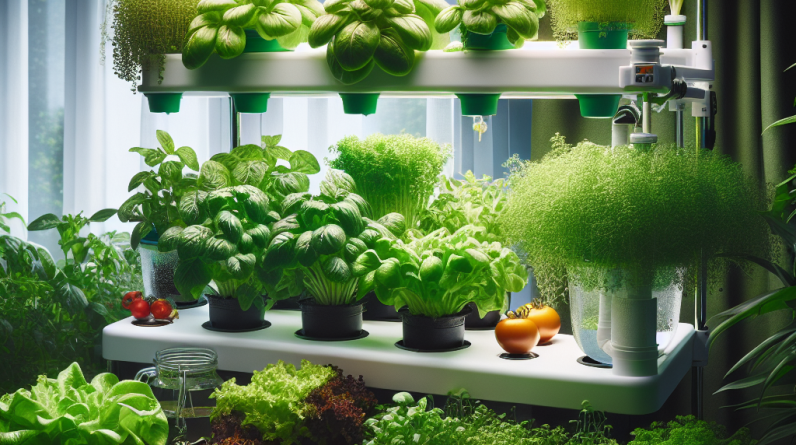
Understanding Hydroponics
What is Hydroponics?
So, let’s kick things off with the basics. Hydroponics is pretty cool; it’s a method of growing plants without soil. Instead, you use a nutrient-rich water solution. Sounds like magic, right? But seriously, it’s no witchcraft; it’s all based on science and how plants absorb nutrients. This opens up a whole new world for anyone who loves gardening!
By skipping the soil, you eliminate many issues like weeds and pests that can complicate the gardening experience. Plus, hydroponics allows for faster growth and higher yields since the plants can directly access nutrients. It’s an incredible way to get fresh produce right at home, even if you’re short on space.
This setup can fit just about anywhere. Whether you have a spacious backyard or a cozy apartment balcony, you can create your green haven with hydroponics. Trust me; once you dive in, you’ll wonder why you didn’t start sooner!
Choosing the Right System
Types of Hydroponic Systems
When it comes to hydroponics, there’s a bunch of systems to choose from, and starting can feel overwhelming. But that’s okay! I’ve gone through the options and can help you find what suits your space and needs best.
You have systems like Deep Water Culture, Nutrient Film Technique, and Aeroponics. Each has its perks. For instance, Deep Water Culture keeps the roots submerged in nutrient water, making it great for leafy greens. On the other hand, Aeroponics mists the roots, which is perfect for a variety of crops and saves water.
Don’t forget to consider your space and how much effort you’re willing to put in. If you’re a busy bee like me, maybe go for a straightforward system with less maintenance initially, and as you grow more comfortable, you can explore the complexities!
Preparing Your Space
Location Matters
Now, let’s talk about where to set up your hydroponics garden. Believe me, the location you choose can make or break your plant growth. You’ll want to find a spot that gets good light—whether it’s natural sunlight or grow lights, it’s essential for healthy plants.
I’ve learned from experience that ventilation can’t be overlooked. Plants need good airflow to thrive and prevent mold. Make sure your space is airy; a fan can really come in handy for that.
Also, keep an eye out for temperature. Most plants prefer a stable temperature between 65-80°F. So, make adjustments if you notice fluctuations. I love using a thermometer to keep track, especially during wild weather changes!
Choosing Your Crops
Best Plants for Beginners
Choosing your crops is one of the fun parts when getting into hydroponics! As a beginner, you might want to start with familiar plants that are easy to cultivate. I usually suggest leafy greens like lettuce and spinach—they grow quickly and aren’t too finicky.
Herbs are another great place to start. Basil, mint, and cilantro thrive splendidly in hydroponic setups. Plus, how great is it to have fresh herbs at your fingertips when you’re cooking? It feels impressive every time!
As you get the hang of things, you can gradually experiment with other crops like strawberries or even bell peppers. It’s like a little taste of success every time you harvest; it keeps it exciting!
Nutrient Management
Understanding Nutrients
Nutrient management can feel geeky, but it’s crucial for producing robust plants. Basically, you need to ensure that your plants get the right balance of macronutrients (like nitrogen, phosphorus, and potassium) as well as micronutrients.
One of my favorite tips is to invest in a good hydroponic nutrient solution. They typically come mixed and ready to go, but make sure to follow the instructions on dosage. You can always adjust based on the growth stage of your plants.
Lastly, every once in a while, check the pH level of your water. Plants dig a slightly acidic pH of around 5.5 to 6.5. It’s a simple step, but it’s the difference between thriving and just surviving. A pH meter is a handy tool to have at your side!
FAQs
1. How much space do I need for a hydroponic garden?
It really depends on the system and plants you choose. Some systems are compact enough for a countertop, while others need more room. Just start small with a few plants and see how it goes!
2. Do I need special equipment?
Yes, but it doesn’t have to be fancy. Basic items include a hydroponic setup (like a small grow box), nutrient solutions, and proper lighting. You don’t need all the bells and whistles when you’re starting out.
3. Is hydroponics expensive?
It can be, but it doesn’t have to be. You can get kits that fit various budgets. Initially, the setup may feel pricey, but you’ll save money in the long run by growing your produce.
4. How often do I need to monitor my plants?
I recommend checking them a few times a week at first. Look at their water levels, nutrient balance, and general health. The more you pay attention, the better you’ll understand how your plants grow!
5. Can I grow fruits using hydroponics?
Absolutely! Once you’re comfortable with your system, you can try growing fruits. Strawberries and tomatoes are popular picks for hydroponic gardens, and they flourish beautifully.
Related Content
- Hydroponics Growing System Indoor Garden Kit Review
- Self-reliant Living by Using a Hydroponic Gardening System – Unleashing the Power of Modern Farming
- Customize Your Hydroponic System for Any Plant
- Hydroponic Gardening: A Modern Way to Grow
- The Ultimate Guide to Indoor Hydroponic Gardening in 2025: 10 Effective Tips to Grow Better







